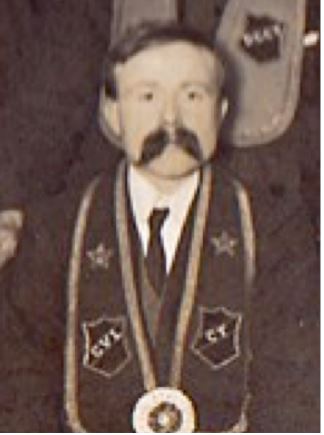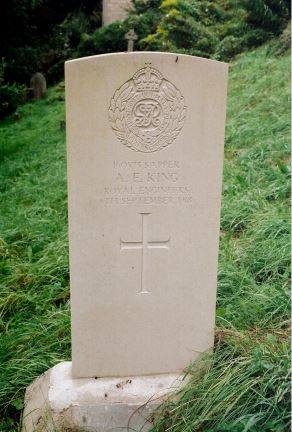2nd Reserve Battalion, Royal Engineers

Albert Edward King was born on 5 February 1879, the fourth and youngest child and only son of Charles and Sarah King who lived on Chalford Hill.
The 1891 Census states that Charles, aged 45, was a stick dresser and his two daughters, Rosina 15 and Frances 17, were bone workers. Albert was at school.
Sarah King died in 1898 aged 56 and was buried at Chalford Church on 16 December 1898.
By the time of the 1901 Census, Albert appears to have left home and was lodging with a couple in Chalford. His occupation was ‘stick maker’. The 1911 Census shows Charles King as living at the Stroud Union Workhouse. He died at the County Asylum Gloucester and was buried at Chalford Church on 3 July 1915.
By 1911, Albert was a member of Chalford IOGT – International Organisation of Good Templars. There is a photo of him dated 1911 on the Imperial War Museum (IWM) ‘Lives of the First World War’ website.
The 1911 Census finds Albert living on his own at Randalls Green near Chalford. He describes his occupation as ‘cabinet maker — maker of tables, chest of drawers and wardrobes. Dealer in fine woods’.
I have been unable to find any military service records apart from inclusion in the UK Army Register of Soldier’s Effects. This states that Albert died at Northumberland War Hospital Gosforth Newcastle. His service number is given plus 202 Field Company I believe this was part of the 30th Division — the 202 being ‘County Palatine’*. St Nicholas Hospital Gosforth, was Northumberland No 1 War Hospital during the war. I have contacted Tyne and Wear archives but no records pertaining to its use during the war survive. It is now a psychiatric hospital.
There is a piece relating to Albert’s experiences on the IWM website, dated 9 November 1917: ‘Albert, son of Mr Chas King, Chalford Hill, reported as having been home on leave. He had taken part in ‘some of the latest pushes’ – He says the Tommies are mighty quick in bestowing names on particularspots, and that these become known in no time. On one occasion a German shell landed at the corner of an important road. It did not explode, and was left untouched, but the place was promptly named ‘Dud Shell Corner’. Another spot, under the observation of the Germans, was entitled ‘Suicide Alley etc’.’
Albert died on 6 September 1918, aged 39. His death was reported in the Stroud Journal dated 13 September:
‘News has been received of the death in Newcastle Hospital of Sapper Albert King of the Royal Engineers. He is the son of the late Charles King of Chalford Vale who is buried in Chalford Church. Sapper King was a member of the Tabernacle and will be buried at Chalford Church on Saturday with full military honours. He is the 8th member of the local IOGT to make the supreme sacrifice.’
He belonged to the Chalford Tabernacle Mens’ Own Brotherhood and said to be a ‘useful member of the brotherhood’.
The report of Albert’s funeral dated 20 September 1918 states: ‘Albert King is described as being of a quiet, unassuming disposition, and was respected by all who knew him. He had been in France for about two years’. Three volleys were fired across his grave and the Last Post sounded.’
The tribute in the Baptist Annual Report of 1919 stated: ‘He had by his quiet, consistent life won his way into our hearts’.
I think it is likely that Albert was engaged to be married. Frances Clara Mason was both the sole beneficiary of his estate and war gratuity. Authority (with letters of administration) was given on 24 February 1919 for a payment of £44 10s 9d with a War Gratuity of £10 10s.
Albert’s will was proved at Gloucester on 28 October 1918. He left £94 3s 4d to Clara who was described as spinster. Clara was two years Albert’s junior and was the only surviving child of four born to George and Mary Mason who lived at Oakridge. Clara was a stick painter. From the available records it appears that Clara married Edmund Hill in 1920 but died just three years later aged 39.
Sapper King’s grave in Chalford (Christ Church) Churchyard is marked by a standard CWGC headstone.

Researched by Helen Wollington 30 November 2015
